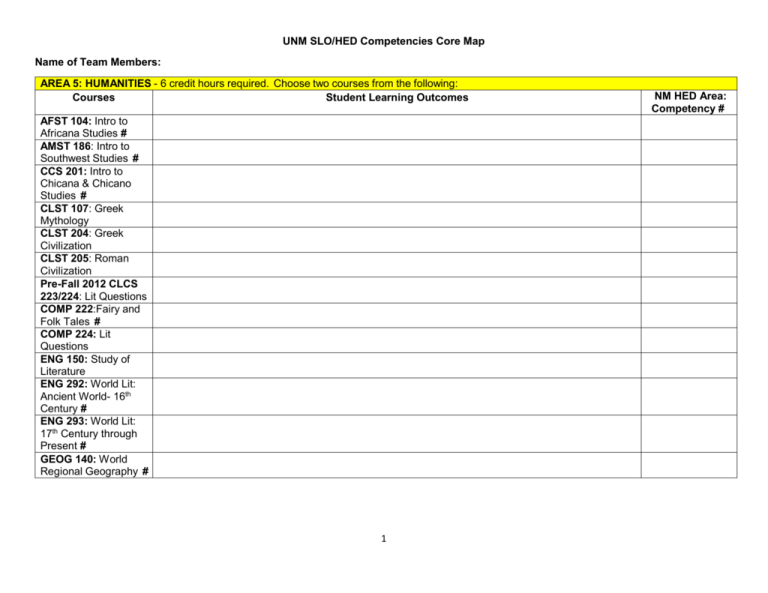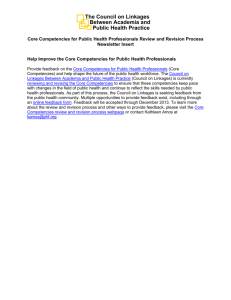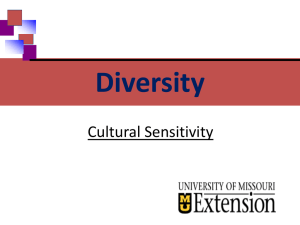Area V - Master list
advertisement

UNM SLO/HED Competencies Core Map Name of Team Members: AREA 5: HUMANITIES - 6 credit hours required. Choose two courses from the following: Courses Student Learning Outcomes AFST 104: Intro to Africana Studies # AMST 186: Intro to Southwest Studies # CCS 201: Intro to Chicana & Chicano Studies # CLST 107: Greek Mythology CLST 204: Greek Civilization CLST 205: Roman Civilization Pre-Fall 2012 CLCS 223/224: Lit Questions COMP 222:Fairy and Folk Tales # COMP 224: Lit Questions ENG 150: Study of Literature ENG 292: World Lit: Ancient World- 16th Century # ENG 293: World Lit: 17th Century through Present # GEOG 140: World Regional Geography # 1 NM HED Area: Competency # HIST 101: Western Civilization (to 1648) By the end of the course, students will be able to distinguish between primary and secondary sources and identify and evaluate evidence. V: 1-2 Elaborated competencies: Students will be able to analyze primary sources and secondary sources. Students will be able to understand interpretive differences. By the end of the course, students will be able to demonstrate in discussion and written work their understanding of different peoples and cultures in past environments and of how those cultures changed over the course of the centuries. V: 2 IV: 1-2 Elaborated competencies: Students will be able to apply relevant historical facts and context. By the end of the course, students will be able to demonstrate in written work and class discussions the ability to recognize and articulate the diversity of human experience, including ethnicity, race, language, gender, as well as political, economic, social, and cultural structures over time and space. V: 3 IV: 1-2 Elaborated competencies: Students will be able to develop interpretation based on different categories of analysis. By the end of the course, students will be able to produce their own historical analysis of documents and develop the ability to think critically and historically when discussing the past. Elaborated competencies: Students will be able to frame historical questions. Students will be able to develop an interpretation based on evidence. Students will be able to employ a broad range of sources. Students will be able to demonstrate an ability to communicate effectively. By the end of the course, students will be able to demonstrate ethical use of sources and provide accurate and properly formatted citations in formal papers. 2 V: 1-2 HIST 102: Western Civilization (from 1648) # By the end of the course, students will be able to distinguish between primary and secondary sources and identify and evaluate evidence. V: 1-2 Elaborated competencies: Students will be able to analyze primary sources and secondary sources. Students will be able to understand interpretive differences By the end of the course, students will be able to demonstrate in discussion and written work their understanding of different peoples and cultures in past environments and of how those cultures changed over the course of the centuries. V: 2 IV: 1-2 Elaborated competencies: Students will be able to apply relevant historical facts and context By the end of the course, students will be able to demonstrate in written work and class discussions the ability to recognize and articulate the diversity of human experience, including ethnicity, race, language, gender, as well as political, economic, social, and cultural structures over time and space. V: 3 IV: 1-2 Elaborated competencies: Students will be able to develop interpretation based on different categories of analysis. By the end of the course, students will be able to produce their own historical analysis of documents and develop the ability to think critically and historically when discussing the past. Elaborated competencies: Students will be able to frame historical questions. Students will be able to develop an interpretation based on evidence. Students will be able to employ a broad range of sources. Students will be able to demonstrate an ability to communicate effectively. By the end of the course, students will be able to demonstrate ethical use of sources and provide accurate and properly formatted citations in formal papers. 3 V: 1-2 HIST 161: History of the US to 1877 By the end of the course, students will be able to distinguish between primary and secondary sources and identify and evaluate evidence. V: 1-2 Elaborated competencies: Students will be able to analyze primary sources and secondary sources. Students will be able to understand interpretive differences. By the end of the course, students will be able to demonstrate in discussion and written work their understanding of different peoples and cultures in past environments and of how those cultures changed over the course of the centuries. V: 2 IV: 1-2 Elaborated competencies: Students will be able to apply relevant historical facts and context. By the end of the course, students will be able to demonstrate in written work and class discussions the ability to recognize and articulate the diversity of human experience, including ethnicity, race, language, gender, as well as political, economic, social, and cultural structures over time and space. V: 3 IV: 1-2 Elaborated competencies: Students will be able to develop interpretation based on different categories of analysis. By the end of the course, students will be able to produce their own historical analysis of documents and develop the ability to think critically and historically when discussing the past. Elaborated competencies: Students will be able to frame historical questions. Students will be able to develop an interpretation based on evidence. Students will be able to employ a broad range of sources. Students will be able to demonstrate an ability to communicate effectively. By the end of the course, students will be able to demonstrate ethical use of sources and provide accurate and properly formatted citations in formal papers. 4 V: 1-2 HIST 162: History of the US since 1877 By the end of the course, students will be able to distinguish between primary and secondary sources and identify and evaluate evidence. V: 1-2 Elaborated competencies: Students will be able to analyze primary sources and secondary sources. Students will be able to understand interpretive differences. By the end of the course, students will be able to demonstrate in discussion and written work their understanding of different peoples and cultures in past environments and of how those cultures changed over the course of the centuries. V: 2 IV: 1-2 Elaborated competencies: Students will be able to apply relevant historical facts and context. By the end of the course, students will be able to demonstrate in written work and class discussions the ability to recognize and articulate the diversity of human experience, including ethnicity, race, language, gender, as well as political, economic, social, and cultural structures over time and space. V: 3 IV: 1-2 Elaborated competencies: Students will be able to develop interpretation based on different categories of analysis. By the end of the course, students will be able to produce their own historical analysis of documents and develop the ability to think critically and historically when discussing the past. Elaborated competencies: Students will be able to frame historical questions. Students will be able to develop an interpretation based on evidence. Students will be able to employ a broad range of sources. Students will be able to demonstrate an ability to communicate effectively. By the end of the course, students will be able to demonstrate ethical use of sources and provide accurate and properly formatted citations in formal papers. 5 V: 1-2 HIST 181: History of Early Latin America # By the end of the course, students will be able to distinguish between primary and secondary sources and identify and evaluate evidence. V: 1-2 Elaborated competencies: Students will be able to analyze primary sources and secondary sources. Students will be able to understand interpretive differences. By the end of the course, students will be able to demonstrate in discussion and written work their understanding of different peoples and cultures in past environments and of how those cultures changed over the course of the centuries. V: 2 IV: 1-2 Elaborated competencies: Students will be able to apply relevant historical facts and context. By the end of the course, students will be able to demonstrate in written work and class discussions the ability to recognize and articulate the diversity of human experience, including ethnicity, race, language, gender, as well as political, economic, social, and cultural structures over time and space. V: 3 IV: 1-2 Elaborated competencies: Students will be able to develop interpretation based on different categories of analysis. By the end of the course, students will be able to produce their own historical analysis of documents and develop the ability to think critically and historically when discussing the past. Elaborated competencies: Students will be able to frame historical questions. Students will be able to develop an interpretation based on evidence. Students will be able to employ a broad range of sources. Students will be able to demonstrate an ability to communicate effectively. By the end of the course, students will be able to demonstrate ethical use of sources and provide accurate and properly formatted citations in formal papers. 6 V: 1-2 HIST 182: Modern By the end of the course, students will be able to distinguish between primary and secondary sources Latin American History and identify and evaluate evidence. # Elaborated competencies: Students will be able to analyze primary sources and secondary sources. Students will be able to understand interpretive differences. By the end of the course, students will be able to demonstrate in discussion and written work their understanding of different peoples and cultures in past environments and of how those cultures changed over the course of the centuries. V: 1-2 V: 2 IV: 1-2 Elaborated competencies: Students will be able to apply relevant historical facts and context. By the end of the course, students will be able to demonstrate in written work and class discussions the ability to recognize and articulate the diversity of human experience, including ethnicity, race, language, gender, as well as political, economic, social, and cultural structures over time and space. V: 3 IV: 1-2 Elaborated competencies: Students will be able to develop interpretation based on different categories of analysis. By the end of the course, students will be able to produce their own historical analysis of documents and develop the ability to think critically and historically when discussing the past. Elaborated competencies: Students will be able to frame historical questions. Students will be able to develop an interpretation based on evidence. Students will be able to employ a broad range of sources. Students will be able to demonstrate an ability to communicate effectively. By the end of the course, students will be able to demonstrate ethical use of sources and provide accurate and properly formatted citations in formal papers. 7 V: 1-2 MLING 101: Language and Cultures # NATV 150: Intro to Native American Studies # PHIL 101: Intro to Philosophical Problems # PHIL 201: Greek Thought By the end of the course, students will be able to explain five problems/issues of the history of Philosophy that have shaped contemporary thought. V: 1 By the end of the course, students will be able to define the main areas of philosophy: metaphysics, epistemology, ethics, aesthetics, etc.; follow the development of at least one of these sub-fields in the history of philosophy. V: 2 By the end of the course, students will be able to analyze a philosophical argument. Students will be able to identify the thesis that the author is trying to establish and identify the premises and intermediate statements that allegedly entail the conclusion. V: 3 By the end of the course, students will be able to evaluate a philosophical argument in terms of the rigor of its logic and the plausibility of its premises (i.e., in terms of validity and soundness). Students will be able to develop and effectively present a counterargument, taking into account other perspectives that find expression in contemporary society/the history of philosophy. V: 4 By the end of the course, students will be able to explain five problems/issues of ancient philosophy that continue to have relevance for contemporary philosophy. V: 1 By the end of the course, students will be able to define the main areas of philosophy: metaphysics, epistemology, ethics, aesthetics, etc.; follow the development of at least one of these sub-fields in ancient philosophy. V: 2 By the end of the course, students will be able to analyze a philosophical argument from an ancient philosophical text. Students will be able to identify the thesis that the author is trying to establish and to identify the premises and intermediate statements that allegedly entail the conclusion. V: 3 By the end of the course, students will be able to evaluate an argument of an ancient philosopher in terms of the rigor of its logic and the plausibility of its premises (i.e., in terms of validity and soundness). Students will be able to develop and effectively present a counterargument, taking into account other perspectives that find expression in contemporary society or ancient philosophy. V: 4 8 PHIL 202: From Descartes to Kant RELG 107: Living World Religions # RELG 263: Eastern Religions # By the end of the course, students will be able to explain five problems/issues of (early) modern philosophy that have helped shape contemporary philosophy. V: 1 By the end of the course, students will be able to define the main areas of philosophy: metaphysics, epistemology, ethics, aesthetics, etc.; follow the development of at least one of these sub-fields in early modern philosophy. V: 2 By the end of the course, students will be able to analyze a philosophical argument from a modern philosophical text. Students will be able to identify the thesis that the author is trying to establish. Students will be able to identify the premises and intermediate statements that allegedly entail the conclusion. V: 3 By the end of the course, students will be able to evaluate an argument of an early modern philosopher in terms of the rigor of its logic and the plausibility of its premises (i.e., in terms of validity and soundness). Students will be able to develop and effectively present a counterargument, taking into account other perspectives that find expression in contemporary society or modern philosophy. V: 4 REL 107 Program Level Student Learning Outcomes for B.A. in Religious Studies Students will be able to articulate how religious symbols and narratives are interpreted and mobilized to construct meaning in human life, by individuals and by communities – and how this changes over time or across different communities. Students will be able to engage in public dialogue and debate regarding ethical and political issues related to religion. Students will be able to articulate their own thoughts clearly in critical discussion and in writing. Students will be able to appreciate the diverse accounts of wisdom and scripturally based moralities articulated by different religious traditions. COURSE LEVEL SLOs FORTHCOMING IN FALL 2015 V: 1-4,7 REL 263 Program Level Student Learning Outcomes for B.A. in Religious Studies Students will be able to articulate how religious symbols and narratives are interpreted and mobilized to construct meaning in human life, by individuals and by communities – and how this changes over time or across different communities. Students will be able to engage in public dialogue and debate regarding ethical and political issues related to religion. Students will be able to articulate their own thoughts clearly in critical discussion and in writing. Students will be able to appreciate the diverse accounts of wisdom and scripturally based moralities articulated by different religious traditions. COURSE LEVEL SLOs FORTHCOMING IN FALL 2015 V: 1-4,7 9 IV: 1-3 IV: 1-3 RELG 264: Western Religions # REL 264 Program Level Student Learning Outcomes for B.A. in Religious Studies Students will be able to articulate how religious symbols and narratives are interpreted and mobilized to construct meaning in human life, by individuals and by communities – and how this changes over time or across different communities. Students will be able to engage in public dialogue and debate regarding ethical and political issues related to religion. Students will be able to articulate their own thoughts clearly in critical discussion and in writing. Students will be able to appreciate the diverse accounts of wisdom and scripturally based moralities articulated by different religious traditions. COURSE LEVEL SLOs FORTHCOMING IN FALL 2015 UHON 205: Humanities Society & Culture # (Honors Legacy Sem, 100-200 level) 10 V: 1-4,7 IV: 1-3








